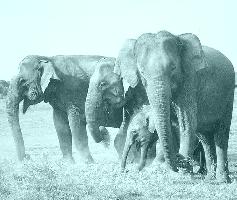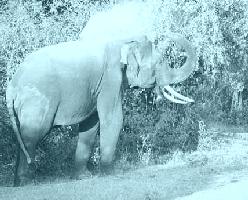

![]()
 Lal
Anthonis
Lal
Anthonis
Q. You have travelled widely in the Sri Lankan wilderness. What, do you see as the biggest threat to our wild life?
A: Poaching, deforesting and killing of elephants by villagers. All these are big problems that the authorities have not been able control. Poaching goes on unchecked in the national parks, because most are bordered by villages. Clearing of forests for chena cultivation and the resulting conflict between villagers and elephants has become a big issue. The use of various chemicals in the agricultural fields has also affected many species In my young days, when I went home to Kitulgala, we would see so many kabaragoyas and herons fishing. But now when I go, there’s none of these. Unknown to us many species are dwindling in number.
Q. What are the problems you see in our national parks?
A: Poaching and the lack of control of it. The Uda Walawe National Park is surrounded by villages. The Wasgomuwa National Park is largely unpatrolled because tracks are made only in a small portion of the park. Staying at a national park, you hear so many gun shots ringing through the night.
I have seen at Uda Walawe, villagers moving aside the electric fencing to bring in their cattle. They remove one post just to take in their cattle for grazing for the day, and the entire village is in danger of elephants coming out of the park through the broken fencing.
There is not enough investment in the national parks themselves. Whatever money is collected at the gates is sent to the treasury and not re-invested in the parks themselves. There are problems of staff shortage in all the parks.
Now Yala is protected by two permanent army camps. This at least has eased the minds of the trackers and rangers of the park. But whether the ‘showpiece of Sri Lankan wildlife’ will ever recover from the incidents of the past is yet to be seen.
Q. Do you feel that the staff of the Department of WildLife is not motivated enough to perform their duties?
A: Definitely. The Department has a low morale. They are under staffed, they do not have equipment and vehicles. Further there is no guidance unlike in the old times when the Department was headed by people not only with a knowledge of wildlife but also a feel for it. I must mention that the younger field staff of the department are very enthusiastic, but they lack training and proper supervision. Sometimes when I go to the parks for photo sessions they come over and ask me about animals.
But at least those in the wildlife parks work in teams, they meet the visitors, get tips, but those in lonely outposts in jungle areas are so abandoned. They have no motivation whatsoever to perform their tasks. When we go to these areas to do some research and visit these guys, they tell us ‘only you remember to come and see us’. Even if there is a complaint by the villagers about a rogue elephant, these men would be frightened to check it out. Especially if someone is killed by an elephant, they will be hesitant to go because the villagers wrath falls on them.
The guns that the department had, were acquired by the government in the JVP times and most were not returned. How can these guys patrol the parks in the night to check for poachers without weapons?
 Elephants
in the wild: villagers see the elephant as their enemy. (Pix by Lal Anthonis)
Elephants
in the wild: villagers see the elephant as their enemy. (Pix by Lal Anthonis)
Q.
Every week there are several reports of deaths resulting from clashes between
elephants and villagers. Is this the biggest conservation problem we have? What
are your experiences with this problem?
A: Yes, certainly this is the biggest problem concerning wild life in Sri Lanka. The man- elephant conflict. I have had first hand experiences of the problem. The conflict happens when people ignorantly and carelessly cultivate or try to establish villages in places where elephants roam. After cultivations come up it is difficult to keep the elephants away.
I have travelled in the North Central area extensively. That is where the problem is quite severe. Every day there is a report of a man being killed, and every week of an elephant being killed. If this problem continues I would give the elephants, outside of parks, another five to ten years more. That’s all.
Q. What are the areas where this problem is most severe?
A: The North Central Province.In remote villages of Anuradhapura, Habarana and Polonnaruwa areas where there is chena cultivation, villagers are constantly locked in a battle with herds of elephant. Sigiriya, Minneriya, Habarana, Huruluwewa, Karuwalagaswewa, and Galenbindunu wewa are some of the other affected areas.
The problem is that villagers and local politicians take this matter too lightly until it is too late. Recently a housing scheme was coming up on the Puttalam Anuradhapura road, near Tabbowa wewa, right in the way of an elephant crossing. The scheme, fortunately, was abandoned after much pressure. Last Vesak, I saw a large herd of about 50 animals near that tank. This kind of careless decision making is seen all too often.
Q. What would you suggest as a solution to the man- elephant conflict?
A: There is no easy solution. For years this problems has been there and is getting progressively worse. The relevant authorities must get together in a concerted effort- the Department of WildLife, the Forest Department, the Agriculture Department and the Ministry of Environment and monitor the setting up of villages, and the spread of chena cultivation. There should be studies done on elephant movement , their habitat and people should be kept out of that range.
Another fact is that most villagers have come to see the elephant as an enemy. They should be made to see the animal as a boon- a way of generating income through tourist traffic maybe. In some countries wildlife experts have successfully got the co-operation of the villagers to conserve the elephant.The villagers get some profit out of protecting the animal by conducting treks to see the animals etc.
 Q.
Are there any other animals that are threatened in our wilds?
Q.
Are there any other animals that are threatened in our wilds?
A: Well, some years ago when I used to stay over at the Habarana rest house, I would quite often hear the leopard call very close late in the night. I have seen leopards on the main roads from Sigiriya to Minneriya and at Koslanda near Diyaluma falls. At Hakgala Gardens once the warden told me to watch out for leopard. Nowadays sighting a leopard , even in a national park is very rare. Then there is the bear. It is an elusive creature and therefore it’s difficult to say really. But in the 1970s when I used to go to Monaragala, there were reports of bear attacks at least once a week. Such incidents are not heard of now.
Q. What role does the WildLife and Nature Protection Society play ?
A: We conduct lectures and seminars in schools in remote areas where they do not have access to knowledge on wildlife . We teach students the importance of protecting nature.. We tell them that the wild animal has a dignity of its own. They are not ready to be petted and pampered by all, like what happened at Ahungalle Zoo.
Continue to Plus page 4 - Timely care can beat heart troubles
Return to the Plus contents page
![]()
| HOME PAGE | FRONT PAGE | EDITORIAL/OPINION | NEWS / COMMENT | BUSINESS
Please send your comments and suggestions on this web site to
info@suntimes.is.lk or to
webmaster@infolabs.is.lk